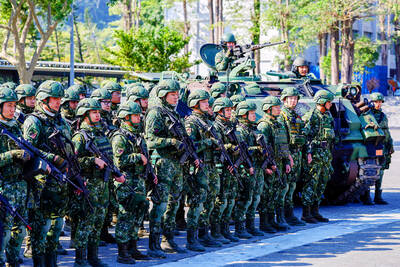Chinese apps are a potential national security risk because of China’s authoritarian political system, two Institute for National Defense and Security Research (INDSR) experts said.
“Information security risks are national security risks,” said Tzeng Yi-suo (曾怡碩), an associate research fellow at the INDSR’s Division of Cyber Security and Decision-making Simulation.
“As long as the app is under the jurisdiction of the Chinese government, there will basically be security concerns,” he added.

Photo: Reuters
Tzeng said that commercial companies collect data about app users and then use algorithms to tailor information and marketing.
This is not a problem in a democratic country governed by the rule of law such as Taiwan, because if the information involves judicial cases, the government would be required to go through legal procedures to obtain the information, he said.
However, the National Intelligence Law of the People’s Republic of China and the Law of the People’s Republic of China on Guarding State Secrets empower Chinese government agencies to require platform service providers to hand over users’ data “as long as they determine that national security is involved,” he said.
“How the Chinese government obtains the data and what it does with it is not transparent,” he added.
In areas under China’s authoritarian control, including Hong Kong and Macau, China “can assert its sovereignty” and “investigate the words and actions of users” using data collected by Chinese apps, he said.
In places outside its jurisdiction, “China’s authoritarian system” still poses risks to users, said Lee Jyun-yi (李俊毅), an associate research fellow at the INDSR’s Division of National Security Research.
Lee cited the US court testimony of former employees of ByteDance, TikTok’s parent company, as evidence that “TikTok does indeed transmit users’ personal information back to China.”
In addition to the security of personal data, Chinese apps such as Douyin and TikTok pose risks relating to the spread of false information, Lee said.
Lee said that although misleading information is not limited to Chinese apps, popular Western platforms such as Facebook, Instagram and YouTube have adopted new methods to crack down on bot accounts and mark state-funded media.
“TikTok’s lack of effort to do so makes it relatively easy for false information to spread,” he said, adding that Chinese apps might “shape users’ perceptions” with the use of algorithms.
Up to 40 percent of popular videos on Chinese apps come from accounts controlled by the Chinese government, he said.
“The Chinese government has implemented legislation which requires media platforms’ algorithm recommendation models to comply with the values of the Chinese Communist Party,” he said.
Taking Douyin as an example, Lee said that the platform promotes content that is “beneficial to China,” and the Chinese government requires the platform to self-censor.
This makes it “difficult for short videos that are negative or critical of China to appear or spread, which has a long-term effect in shaping people’s perceptions,” he added.
The two security experts are not alone in their concerns about Chinese apps such as TikTok.
In March, then-minister of digital affairs Audrey Tang (唐鳳) said TikTok had been classified as a “dangerous product.”
The use of the app is banned in government agencies and on their premises in Taiwan.
In April, US President Joe Biden signed into law a bill titled Protecting Americans from Foreign Adversary Controlled Applications Act, which requires ByteDance to divest its US assets or face a nationwide ban. The earliest such a ban could go into effect would be Jan. 19 next year.
India completely banned TikTok in June 2020, while countries including Australia, the UK, France, the Netherlands, Norway, Belgium, Denmark, Canada and New Zealand have separately imposed rules limiting certain people, especially government employees, from using the app due to cyber-security concerns.

UNILATERAL MOVES: Officials have raised concerns that Beijing could try to exert economic control over Kinmen in a key development plan next year The Civil Aviation Administration (CAA) yesterday said that China has so far failed to provide any information about a new airport expected to open next year that is less than 10km from a Taiwanese airport, raising flight safety concerns. Xiamen Xiangan International Airport is only about 3km at its closest point from the islands in Kinmen County — the scene of on-off fighting during the Cold War — and construction work can be seen and heard clearly from the Taiwan side. In a written statement sent to Reuters, the CAA said that airports close to each other need detailed advanced

Tropical Storm Fung-Wong would likely strengthen into a typhoon later today as it continues moving westward across the Pacific before heading in Taiwan’s direction next week, the Central Weather Administration (CWA) said. As of 8am, Fung-Wong was about 2,190km east-southeast of Cape Oluanpi (鵝鑾鼻), Taiwan’s southernmost point, moving westward at 25kph and possibly accelerating to 31kph, CWA data showed. The tropical storm is currently over waters east of the Philippines and still far from Taiwan, CWA forecaster Tseng Chao-cheng (曾昭誠) said, adding that it could likely strengthen into a typhoon later in the day. It is forecast to reach the South China Sea

Almost a quarter of volunteer soldiers who signed up from 2021 to last year have sought early discharge, the Legislative Yuan’s Budget Center said in a report. The report said that 12,884 of 52,674 people who volunteered in the period had sought an early exit from the military, returning NT$895.96 million (US$28.86 million) to the government. In 2021, there was a 105.34 percent rise in the volunteer recruitment rate, but the number has steadily declined since then, missing recruitment targets, the Chinese-language United Daily News said, citing the report. In 2021, only 521 volunteers dropped out of the military, the report said, citing

WEATHER Typhoon forming: CWA A tropical depression is expected to form into a typhoon as early as today, the Central Weather Administration (CWA) said yesterday, adding that the storm’s path remains uncertain. Before the weekend, it would move toward the Philippines, the agency said. Some time around Monday next week, it might reach a turning point, either veering north toward waters east of Taiwan or continuing westward across the Philippines, the CWA said. Meanwhile, the eye of Typhoon Kalmaegi was 1,310km south-southeast of Oluanpi (鵝鑾鼻), Taiwan’s southernmost point, as of 2am yesterday, it said. The storm is forecast to move through central